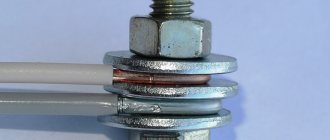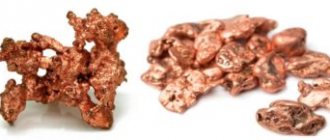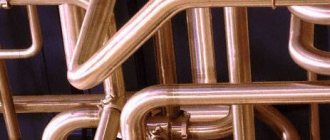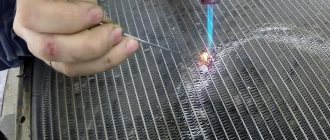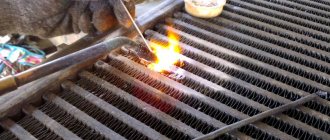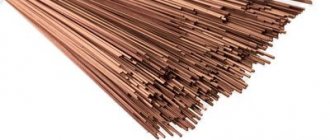Copper is a metal that has low activity and for this reason is often used for decorative purposes. Copper is used to make jewelry, home decoration, art, furniture and much more. The metal surface oxidizes under the influence of oxygen, but due to its low activity, this may take decades. The consequence of this reaction is patina - a surface film that most often has a greenish tint. Patina prevents the metal from being damaged, so it is important to know how to blacken copper at home.
Copper before and after blackening
There are two types of reactions that lead to the formation of films on the surface of copper:
- oxidation - the process of formation of oxides and oxides, elements containing oxygen;
- patination - a film is formed under the influence of sulfur and chlorine.
If you dip a copper piece in a solution designed to create a patina on its surface, it will immediately be transformed and, while sparkling new, will look like an antique. There are two main types of methods by which this effect is achieved, some are based on improvised means, while others require chemical solutions. They can be dangerous, so you need to work in compliance with all safety regulations. The room must have a fume hood.
Before you start blackening, you need to prepare the metal: clean, degrease, rinse and dry. For drying, do not use the towel wiping method. This can lead to fabric residues on the products, water in the recesses of the relief, and damage to the decorative part. You can use sawdust for this purpose.
How to change the color of metal?
How to change the color of metal to make it look like antique? Since time immemorial, craftsmen have used the methods of oxidation, bluing and patination.
Various methods are used to carry out the work:
- Metal processing over an open fire . This method is one of the most popular and ancient among jewelers. For a more beautiful and even color, it is recommended to calcinate the wire over an open fire in advance, even before creating the decoration. This is due to the fact that the heating rate of the metal may differ in different areas, therefore, there is a danger of burning it out and making it brittle. In addition, if the original working metal is varnished, the fire will remove it and pre-prepare the wire for work.
- Treating metal with a sulfur liver creates a patination effect. Typically a proportion of 50 ml of water/1 drop of product is used. It is recommended to use water at 20-23 degrees, close to room temperature, since with hotter water the patination reaction occurs faster, and the resulting patina becomes less stable and will begin to wear off when it touches clothing, skin, or the surface of the box.
- Ammonia solution (in the first case, exclusively its vapors are used). To process, place the decoration in a jar with a lid, into which pour 1 ml of ammonia of 5% concentration. The color of the metal changes relatively quickly; it can be adjusted by observing the changes over time.
- Ammonia solution (in the second case it is used together with water). For processing, the product is sprayed with water or placed directly into the solution for 1 second, and then it is sent to a container where ammonia vapor is formed. Under the influence of water and ammonia in steam, the color of the patina becomes close to blue.
Quick ways
At home, patination of copper can be done faster. This process does not require special compounds or special safety precautions. The simplest method is heat treatment. If you expose a material to fire, it reacts instantly. The longer the firing takes place, the darker the color of the oxide film becomes. After the procedure, it is better to immerse the material in water so that the effect is fixed, then the product must be treated with varnish.
Another simple way is using eggs. Once cooked and cooled, they need to be cut or mashed into small pieces (with or without shell, it doesn’t matter). Then you need to put the crushed products in any sealed container (a saucepan, for example), where the product is placed. Boiled eggs will release sulfur, and within thirty minutes the first result will be visible. The longer the procedure is carried out, the darker the effect.
What does it mean to “patina” a product?
What does “patina” mean in terminology? This means coating metal products with a special coating that will give the item an antique appearance. Metal products can be patinated using chemical compounds, solutions, vapors, after contact with which the product changes color and becomes special.
The film that forms on the product after the patination process is protective and, when used, protects the metal from environmental influences and external aggressive conditions.
Various natural shades of patina on copper products are known. Green, olive, blue, brown, reddish, close to black. These colors appear on copper and copper-containing alloys - brass and bronze. The patina that forms naturally on metal looks beautiful and even has the epithet “noble”.
Aesthetic and practical effects prompted jewelers and decorators to invent ways to create artificial patina as a way of aging a product. There are two ways to patina metal: random and stable.
With a stable method, the result of patination can be accurately calculated. For example, if you use liver sulfur, the coating will turn out to be brown in color; the degree of its saturation can be adjusted by exposure time.
With a random method of applying patina, the result cannot be predicted, since it will depend on how the metal behaves in reaction to certain agents. But this method always produces an interesting and artistically valuable result.
There are a variety of agents and reagents available for plaque formation. Let's consider the most popular ones for patination of copper and brass.
Purposes of using patination
Old copper products that have survived to this day have a natural film of oxides and nitrogens. The image of ancient, valuable things is attached to the patinated material. Nowadays, artificial darkening is most often used to enhance products for the purpose of profitable sale. This method makes it possible to give the product a rare look, increasing its exclusivity and, consequently, its value.
Copper patination
Patination of brass: means and methods
When patination of brass with ammonia vapor, it should be taken into account that this metal is more fragile, and prolonged exposure can trigger the process of destruction. It is not recommended to leave the product for longer than 20-25 minutes, otherwise the wire will be broken.
Brass after chemical patination gives amazing colors: from yellow and red to purple and black. Note that this variety can be formed on one product.
Using patination with sodium triosulfate (hyposulfite) and nitric acid, you can achieve gray shades in aging brass. The process goes as follows.
Half a liter of hot water is poured into the container, 25-30 grams of hyposulfite and 1-2 teaspoons of nitric acid are added. The solution acquires a yellow-green tint and a sulfuric odor. Place a brass product in this liquid for 15 minutes and observe the oxidation process. After obtaining the initial effect, use tweezers to remove the product from the solution and wash it with hot water.
The clean product should be wiped with sand and dipped into the chemical composition again. Repeated processing gives the final color and streaks. After rinsing again with hot water, the product is cleaned with pumice powder, which is washed off after wiping. Patinated brass is dried in a layer of sawdust, after which it is treated with velvet cloth, machine oil and varnished.
Thus, any new product made of copper, brass, bronze can be given a noble antique look using the patination method. Patina not only creates an additional color scheme for the decoration, but also protects the metal from adverse external influences, thereby increasing its service life.
Preparing for patination
To carry out any chemical reaction, safety rules must be followed. In the specific case of artificial patination, it is important to remember that the process uses toxic chemical compounds, the released vapors of which are poisonous. For safety reasons, you must follow the rules:
- Properly store substances necessary for a chemical reaction. Sealed containers should be used to prevent toxic fumes from being released into the air.
- Carefully prepare the materials themselves: clean copper or its alloys, then degrease and wash in water at above average temperature.
- Carry out the procedure itself in a safe environment. Most often, a special cabinet with a ventilation hood is used.
After coating, it is also better to follow certain recommendations. The products should be rinsed again in warm water and dried. It is not recommended to wipe with fabric materials, since they can damage the patina layer that has not yet hardened and remove water only on the surface layers. For safe and high-quality drying, sawdust is used in most cases.
Visual results of pattinating copper, brass and nickel silver
Pattinating and oxidation
Change in color of metals in an aqueous solution of liver sulfur
Change in color of metals in ammonia vapor
Oxidation in ammonia vapor
A 10% ammonia solution will help give copper a brown, olive or even bluish tint. If you are trying to achieve a result with blue flecks, place the product in a solution of table salt before processing. In this case, oxidation occurs quickly, in ten or fifteen minutes. For a more noble and deep olive color, the item should be kept for six to eight hours in an airtight container with a solution poured into a small bowl.
Copper coin before and after patination
How to care for copper products?
There are several recommendations regarding the proper care of copper items. They will help preserve the natural appearance of the metal for as long as possible, so do not neglect them.
There are several such recommendations:
- Copper utensils must be kept clean regularly. After each use, wash thoroughly and dry with a towel. Residual moisture may cause the surface to turn black.
- For cleaning, do not use abrasive substances, as well as products containing chlorine and ammonia. To prevent scratches on the surface, do not use metal spatulas, spoons, or coarse bristled brushes for cleaning.
- Copper jewelry should be wiped with damp wipes as often as possible. This is necessary in order to remove sebum from their surface.
- Products should only be washed by hand, do not use a dishwasher.
If you follow these fairly simple tips, you can significantly extend the life of copper products, as well as maintain their natural shine.
Patina on zinc coins
Zinc patinated coins have the most deplorable appearance. Shown above is a selection of small denominations from Denmark, the Netherlands and Luxembourg from the First and Second World Wars. In difficult times, metal becomes a strategic raw material, so coins have to be made from the cheapest material. Patina causes zinc coins to darken to such an extent that it is sometimes difficult to make out the designs and inscriptions on them. It is not surprising that after economic recovery, all these countries abandoned zinc coins, choosing other metals and alloys.
Patina on aluminum coins
Aluminum was often used in coinage in the 20th century. Basically, small denominations were made from it (for example, Hungarian fillers). In the GDR, the entire line of coins, with the exception of the heavy brass 20 pfennig used in the machines, was aluminum. The oxidation process quickly deprives the aluminum coin of its stamp shine. It becomes dull and inconspicuous, acquiring a matte gray coating. And if the protruding parts of the relief are still mechanically cleaned during circulation, then the coin field very soon begins to look dirty.
How to darken copper at home - Metals, equipment, instructions
Copper plating is the process of applying a copper layer to the surface using an electroplating method.
The copper layer gives the product visual appeal, which allows the use of copper electroplating in design projects. It also gives the metal high electrical conductivity, which allows the product to be subjected to further surface treatment.
Copper plating can be used as the main process to create a surface layer, and also as an intermediate operation for the subsequent application of another metal layer. This method includes, for example, the process of silvering, chrome plating or nickel plating.
Copper plating can be done at home. This makes it possible to solve many everyday problems.
Copper plating by immersion
The process is carried out following the following steps:
- The oxide film is removed from the surface of the steel part using sandpaper and a brush, and then the part is washed and degreased with soda and a final rinse with water.
- Two copper plates are placed in a glass jar, connected to copper conductors, which serve as the anode. To do this, they are connected together and connected to the positive terminal of the device used as a current source.
- The workpiece is suspended freely between the plates. The negative pole of the terminal is connected to it.
- A tester with a rheostat is built into the circuit to regulate the current.
- An electrolyte solution is prepared, which usually includes copper sulfate - 20 grams, acid (hydrochloric or sulfuric) - from 2 to 3 ml, dissolved in 100 ml (preferably distilled) water.
- The prepared solution is poured into a prepared glass jar. It should completely cover the electrodes placed in the jar.
- The electrodes are connected to a current source. Using a rheostat, the current is set (10-15 mA should be per 1 cm2 of part area).
- After 20-30 minutes, the current is turned off, and the copper-plated part is removed from the container.
:
Copper plating without immersion in electrolyte solution
This method is used not only for steel products, but also for aluminum and zinc products. The process goes like this:
- A stranded copper wire is taken, the insulating coating is removed from one end, and the copper wires are given the appearance of a kind of brush. For convenient use, the “brush” is attached to a handle-holder (you can take a wooden stick).
- The other end of the wire without a brush is connected to the positive terminal of the voltage source being used.
- An electrolyte solution is prepared based on concentrated copper sulfate with the addition of a small amount of acid. It is poured into a wide container, necessary for convenient dipping of the brush.
- The prepared metal part, cleaned of the oxide film and degreased, is placed in an empty bath and connected to the negative terminal.
- The brush is moistened with the prepared solution and moved along the surface of the plate without touching it.
- Once the required copper layer has been achieved, the process ends and the part is washed and dried.
There should always be a layer of electrolyte solution between the surface of the part and the improvised copper brush, so the brush must be dipped in the electrolyte constantly.
Copper plating of aluminum with copper sulfate
Copper coating is a great way to update aluminum cutlery and other aluminum products used in the home.
Copper plating of aluminum with copper sulfate can be done independently. A simplified option to demonstrate the process is to coat a simple shaped aluminum plate with copper.
You can practice with this example. The process goes like this:
1. The surface of the record must first be cleaned and then degreased.
2. Then you need to apply a little concentrated solution of copper sulfate (copper sulfate) to it.
3. The next step is to connect the wire connected to the negative pole to the aluminum plate. You can connect the wire to the plate using a regular clamp.
4. A positive charge is applied to a device consisting of bare copper wire with a diameter of 1 to 1.5 mm, the end of which is distributed between the bristles of the toothbrush.
During operation, this end of the wire should not touch the surface of the aluminum plate.
5. Having dipped the bristles in a solution of copper sulfate, begin to move the brush in the place prepared for coating with copper. In this case, there is no need to close the circuit by touching the surface of the aluminum plate with the end of the copper wire.
6. Copper plating of the surface immediately becomes visually noticeable. In order for the layer to be of high quality, there is no need to rush to complete the process.
7. After completing the work, the copper layer must be leveled by additional cleaning, removing the remaining copper sulfate and wiping the surface with alcohol.
Galvanoplasty at home
Galvanoplasty is the process of electrochemical action on a product in order to give it the required shape by depositing metal on the surface.
Typically this technology is used for metal coating of non-metallic products. It is widely used in jewelry and the design of household items.
The coating of the work product must have electrically conductive properties. In the absence of such a layer, the object is first coated with graphite or bronze.
Electroplating at home is especially popular among craftsmen. To create the desired shape, a cast is made from the copy. For this purpose, easily melting metal, graphite and gypsum are used.
:
After the mold is made, the object is plated using an electrolyte.
Patina on silver coins
Iridescent patina on silver coins can be found much more often than on copper. Previously, such a variety of colors could greatly increase the price, since such a specimen looked very advantageous against the background of ordinary coins, even if they had a stamp shine. Nowadays, there are many ways to create a rainbow patina. However, the artificial patina stands out with bright, unnatural colors that scare off experienced collectors and attract only beginners.
Let's look at the classic bullet patina. Its name comes from the similarity of the coin, which has such a patina, to one of the types of bullet targets. The coin field of the Soviet silver fifty-kopeck piece shown above contains smooth transitions of patina from light to dark tones, like on a target.
Tsarist and early Soviet bilon coins are 500-carat silver. The alloying additive to the precious metal is copper. Due to its presence, a thin layer of silver sulfide may form on the coin - a malachite-colored patina. It reduces, rather than increases, the price of the coin, so they are trying to remove it.
About the use of sulfur ointment
Judging by the reviews, home craftsmen often have the opportunity to work with copper rings and other small items - pendants and earrings. In such cases, experts recommend blackening copper with sulfur ointment. According to many craftsmen, the ointment can be applied to the product and washed off after some time. However, in this case, the result is often unpredictable: you have to wait a long time for the color to change, and it also happens that darkening may not occur. In connection with this fact, many home craftsmen practice blackening with vapors of sulfur ointment. Patination is carried out as follows:
- To work you will need a glass container. A regular liter jar works well. It must be weighted down by placing a stone on the bottom. Metal objects should not be used, as the metal will react with sulfur, which is undesirable.
- Using a plastic or glass rod, scoop out ointment in the range of 1 to 1.5 cm. and place at the bottom of the container.
- Make a loop from the scaffolding, into which you then need to thread the patinated workpiece. The product should not touch the sulfur, but remain in a suspended position.
- Close the glass container tightly.
- Pour water into a large enamel pan, place a stand on the bottom on which the jar with the copper product will stand. It is not difficult to make a stand from a tin lid from a tea can. To prevent bubbles formed during boiling from raising the jar, it is advisable to equip the lid with several holes.
- Place the pan on a gas or electric stove. When the water boils, the heat can be reduced.
The copper blackening process can last for 2-3 hours. During work, you need to add water to the pan from time to time. In order to provide the product with an uneven patina, experts recommend shaking the jar periodically.
At the end, the copper jewelry being processed is removed from the loop, cooled and thoroughly washed in running water. The liter jar used should be tightly closed with a lid, since with the remaining ointment it will be possible to carry out about seven more patinations in the future.
About patination with potassium sulfide
This method is considered one of the best. The reagent can have a solid, gel-like and liquid state of aggregation. It can be stored in solid form for more than one year, but in liquid form it can be stored for only a couple of weeks. The sulfide must be diluted in water. The solid is first crushed to a powder state, and then filled with water. Metal is dropped into the resulting mixture.
Experts recommend preparing another container with soda diluted in water with a ratio of 1:16. This will allow you to stop the aggressive effect of ammonium on the product in time. The reaction will be stopped if the metal is placed in a container with diluted soda.
Patina on gold coins
Pure gold is a metal that is practically not subject to oxidation. This section appeared only because pure gold was not used for everyday coins of past centuries because of its softness. To give gold strength, it was alloyed with a small amount of other metals (usually silver and copper, less often nickel or molybdenum). The five-ruble note of Nicholas II, taken as an example, is 900-carat gold. The alloying additive to it is still the same copper. Under certain conditions, copper can appear on the surface, and even such a small amount will cause the coin to darken in fragments (as in the illustration above).
More often on gold you can find rust stains, caused by the same oxidation process. During minting, chipped microparticles of the stamp may become pressed into the surface of the gold, and after a few years the coin will become unsightly. In Russian numismatics, the most famous are the rusty gold “Victory Bearers”. After the scandal with SPMD gold coins, Russian minting technology was improved, and such defects began to occur much less frequently. Both rust and patina always reduce the value of gold coins.
Getting patina with an egg
A black-brown patina can be achieved using a boiled egg. The effect is the interaction of the metal surface with sulfur, which is released in the yolk at high temperatures. To do this, you must first boil the eggs, and only then add the copper product to the water. Depending on the size of the product, a different number of eggs will be required.
Another option. After the eggs are hard-boiled (10 minutes), they must be removed from the water and cooled. The peeled eggs are crushed and placed in a container with a wide bottom, and copper is also placed there. The container is closed for 20-30 minutes or more, depending on what color you want to get: over a longer time, the product will become darker. The main advantages of this method are simplicity and accessibility. The main disadvantage is that the effect most likely will not be long-term and the coating will come off.
Patina has excellent properties. For example, in numismatics, the value of an item depends on how uniform it is. Artificial turf cannot replace natural turf.
If the patina has a uniform structure and evenly covers the surface, then it is better to preserve it on the product. This especially applies to antiques and coins. To prevent damage to the top layer, it is necessary to care for the product and handle it with special care. Do not clean with abrasive products or tools. And it’s better not to touch the product with your hands.
But if it has chips, stains, looks ugly or is not uniform, then such methods will do just fine. If you want the patina to lay down evenly, then the old layer must be cleaned to a metallic shine.
Electrochemical method
The most difficult method to carry out at home, but it is suitable for those who are looking for an unusual shade. Carrying out requires the use of electricity and a toxic mixture, so safety precautions must be observed!
- The first step is to prepare the solution: add 60 g of copper sulfate and 90 g of sugar to 300 ml of warm water; separately, dissolve 45 g of caustic soda in the same volume of cold water; then mix both liquids slowly.
- The second step is to heat the water to 80 degrees and keep the product in it for about a minute.
- The third step is to apply electricity, for example, using a car battery: “plus” to the copper anode stick and “minus” to the workpiece. Power - from 0.5 to 1.1 watts.
The color turns out to be very different, depending on the feeding force and processing time. If you do not have time to catch the required color, do not worry and continue patination: it occurs cyclically, you can “catch” the desired shade after some time.
In general, it is quite safe to cover a product with patina, although you will end up with a somewhat trivial option. But to achieve an unusual effect, you cannot do without chemicals, so be very careful.
